Key Elements Of An Effective Restaurant Kitchen Layout
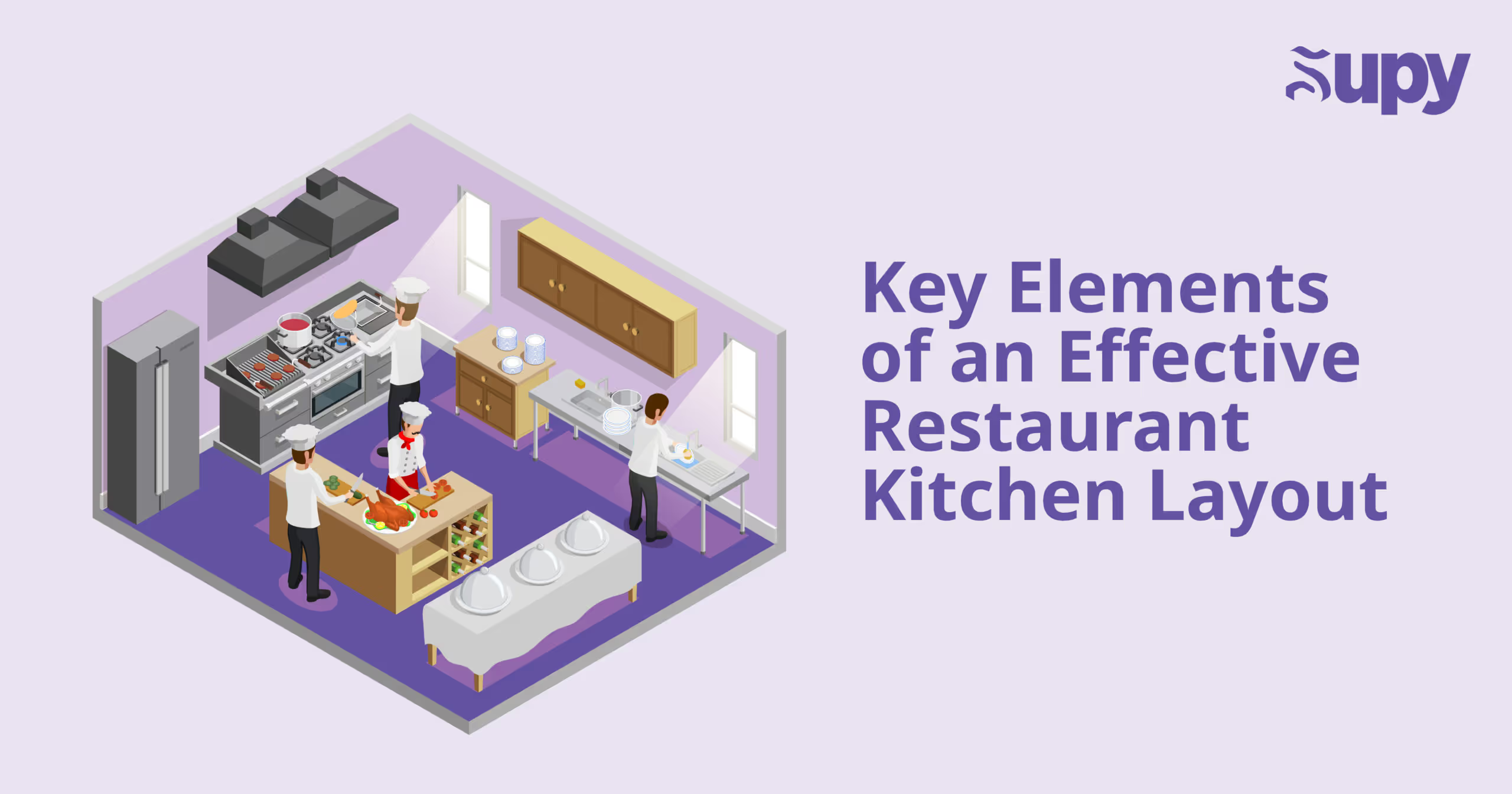
You’ve probably spent hours imagining the perfect dining area for your restaurant, such as the ambiance, the seating, and the lighting, all designed to create an inviting space for your customers. But how much thought have you given to the kitchen? Often hidden from view, the kitchen is where the real work happens, and its design plays a critical role in your restaurant’s success.
An efficient restaurant kitchen layout ensures smooth workflows, consistent food quality, and adherence to safety standards. It minimizes delays, reduces stress for your staff, and allows you to serve your customers efficiently. No matter your restaurant setup idea, understanding the principles of an effective kitchen layout is essential to stay competitive in today’s industry.
In this blog, we’ll explore:
- Why Should Restaurants Focus on Their Kitchen Layout?
- 8 Essential Elements of Effective Kitchen Design
- Key Principles of Designing a Commercial Kitchen
- Common Mistakes and their solutions in Kitchen Layout
- Most Common Kitchen Layout Designs
- Conclusion
- About Supy
Let’s get started and discover how optimizing your kitchen layout can transform your restaurant operations!
1. Why Should Restaurants Focus on Their Kitchen Layout?

The kitchen is the backbone of any food establishment, yet it often doesn’t get the attention it deserves during the planning phase. A well-designed kitchen layout directly impacts how efficiently your staff works, the quality of food served, and the overall safety of the environment. For restaurant owners, focusing on the kitchen layout ensures they are creating a foundation for long-term success.
- Maximize Workflow Efficiency: An optimized kitchen layout ensures that your staff can move smoothly between tasks without unnecessary interruptions. Proper workstation placement reduces bottlenecks and improves coordination, especially during peak hours. Regardless of your restaurant's location, a productive and streamlined kitchen can make a significant difference in customer satisfaction. Every second counts, particularly in a successful restaurant that sees consistent customer demand.
- Enhance Food Quality: A well-organized kitchen also allows chefs to focus on their craft rather than wasting time searching for tools or ingredients. Clear zoning for preparation, cooking, and plating ensures that each dish is prepared consistently. For those developing a business plan, prioritizing a kitchen design that enhances food quality can be a critical step toward operational excellence.
- Prioritize Safety and Hygiene: Strategic placement of cleaning stations, waste bins, and storage areas helps maintain cleanliness throughout the workspace. Proper separation of raw and cooked food zones minimizes cross-contamination risks. A safer kitchen reduces the chances of accidents, protecting both your staff and your customers, ultimately contributing to a thriving restaurant setup.
A kitchen layout can also play a vital role in your advertising and marketing strategies. A well-thought-out, visually appealing kitchen, especially in open-kitchen concepts, can be a unique selling point that attracts customers and sets your restaurant apart. Clean, organized spaces that reflect efficiency and professionalism are great for building your brand’s reputation and can be highlighted in promotional content. The layout needs to align with your management and ownership structure, ensuring seamless collaboration between the front of house and back of house which contributes to a consistent dining experience.
2. 8 Essential Elements of Effective Kitchen Design
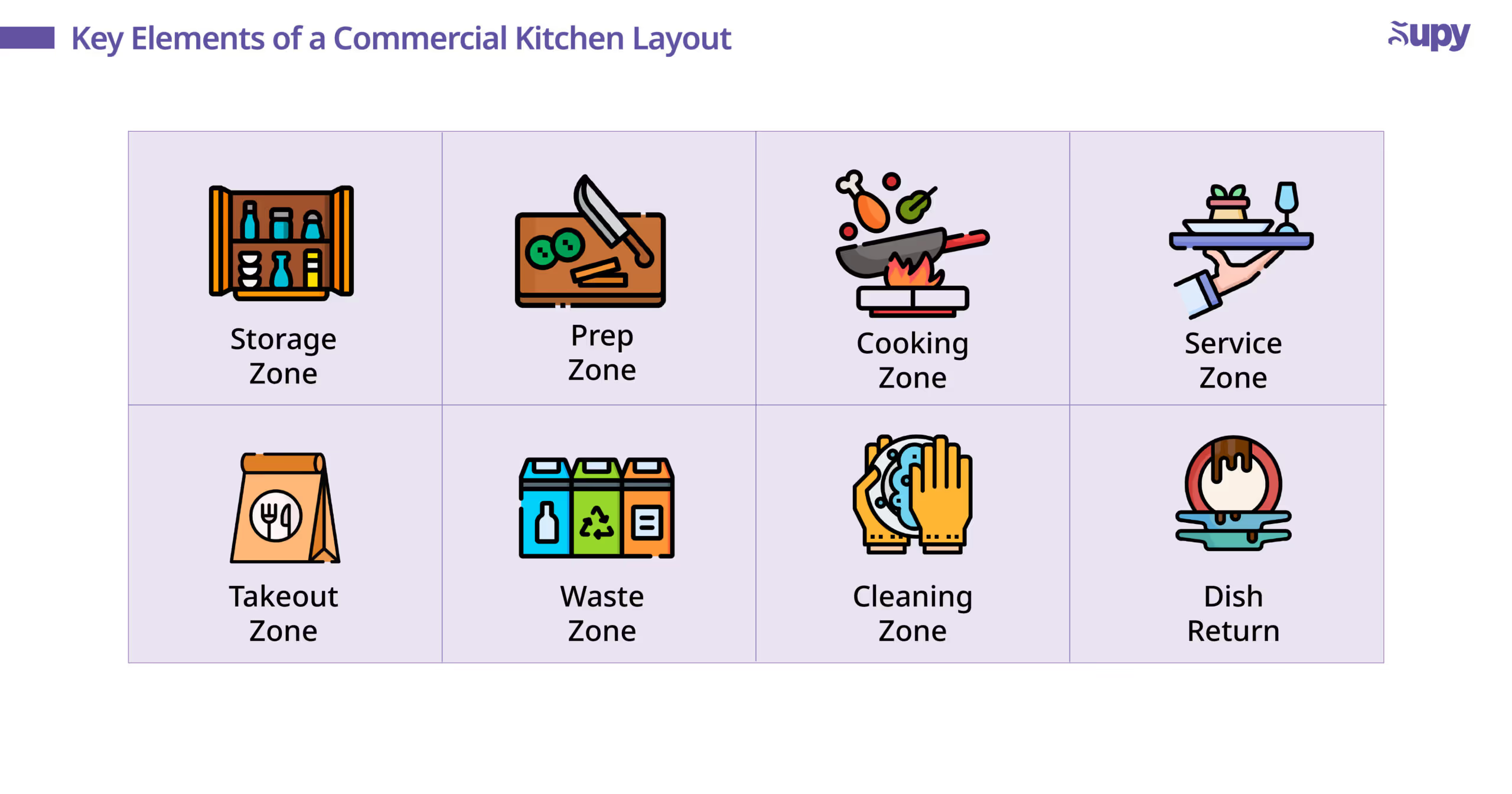
Designing an effective kitchen means more than simply arranging equipment. It’s about creating a space where every area is purpose-built to support the restaurant’s workflow, safety standards, and overall efficiency.
Here are eight critical elements that every restaurant should prioritize when planning their commercial kitchen layout:
1. Ingredient Storage
Storage is a fundamental component of any kitchen and the starting point for an efficient workflow. This zone must be carefully designed to ensure all ingredients are fresh, organized, and easy to access. It’s essential to allocate enough storage space for each type of food, including separate areas for perishables, non-perishables, and bulk supplies. Proper ventilation, temperature controls, and shelving systems are crucial to maintaining food quality and safety.
Positioning food storage areas close to the delivery entrance can save time and effort during restocking. Organized storage not only reduces waste but also improves inventory management. With everything in its place, staff can quickly retrieve what they need, keeping the kitchen space running smoothly even during busy shifts.
2. Preparation Zone
The preparation zone is where raw ingredients are transformed into ready-to-cook components. It needs ample counter space, cutting boards, and essential cooking tools like knives and mixers. This area should be well-lit and equipped with dedicated handwashing stations to maintain hygiene. Staff efficiency in this zone depends on having tools and ingredients within easy reach, so thoughtful organization is key.
Locating the prep area between the storage and cooking zones streamlines workflow, allowing for a seamless transition from ingredient retrieval to cooking. A well-designed preparation zone reduces bottlenecks and ensures tasks like chopping, marinating, and mixing are completed quickly and safely, setting the stage for efficient operations in the back of the house.
3. Cooking Zone
The cooking zone is the heart of the kitchen, where ingredients are turned into finished dishes. This area houses stoves, ovens, fryers, and grills, requiring careful planning to ensure both restaurant efficiency and safety. Adequate ventilation is critical here, as heat, smoke, and grease can quickly accumulate. The placement of restaurant equipment should minimize unnecessary movement, enabling staff to work efficiently even during peak hours.
Safety is paramount in the cooking zone. Fire suppression systems, heat-resistant surfaces, and clearly marked pathways can help reduce risks. Creating a layout that allows chefs to focus on their tasks without obstruction makes the space a hub of productivity that supports the entire restaurant kitchen layout.
4. Plating and Service Zone
Once dishes are cooked, they move to the plating and service zone, where they are assembled, garnished, and sent out to customers. This area must be clean, well-organized, and located near the cooking zone to prevent delays. Adequate counter space is essential to handle multiple orders at once, and specialized equipment like heat lamps ensures dishes stay at the right temperature before serving.
A well-designed service zone also improves communication between kitchen staff and servers. Clear pathways and logical order organization help reduce errors, ensuring that customers receive their meals promptly. For those opening a restaurant, prioritizing a streamlined plating and service area can significantly enhance efficiency during peak hours.
5. Dish Return Area
The dish return area is where used plates, utensils, and glasses are collected after service. This zone should be strategically located to avoid disrupting kitchen workflows. During peak hours, it must efficiently handle large volumes of returns while maintaining hygiene. Conveyor systems or designated drop-off points can help streamline this process.
Keeping the dish return area organized and separate from the prep and cooking zones minimizes the risk of contamination. This separation also ensures that staff can focus on cleaning and returning items to circulation without interfering with other operations, maintaining a smooth and sanitary workflow.
6. Cleaning and Sanitizing Zone
Cleaning and sanitizing are essential to maintaining a safe and compliant kitchen. This zone includes sinks, dishwashers, drying racks, and waste disposal systems. It’s important to provide multiple sinks for tasks like handwashing, rinsing dishes, and cleaning equipment to avoid cross-contamination. Ample drainage and non-slip flooring are crucial for safety in this frequently wet area.
Efficient cleaning practices are supported by a well-organized layout. Placing the cleaning zone near the dish return area reduces the distance items need to travel, saving time and effort. A focus on cleanliness and order here ensures that the kitchen meets health codes, which is vital for obtaining and maintaining your business license.
7. Delivery and Takeout Zone
With the rise of delivery and takeout orders, having a dedicated zone for these activities is essential. This area should be separate from dine-in operations to prevent disruptions. It needs counter space for packaging, shelves for organizing orders, and easy access for delivery drivers to pick up without entering the main kitchen.
A well-designed delivery zone improves restaurant efficiency and ensures that takeout orders are handled with the same care as dine-in meals. Streamlining the process of packing and handing off orders allows restaurants to enhance customer satisfaction and keep up with modern dining trends.
8. Waste Management Zone
Effective waste management is vital for maintaining cleanliness and sustainability in the kitchen. This zone includes bins for general waste, recycling, and composting, along with compactors for reducing volume. Clear labeling and strategic placement of bins near prep and cleaning areas encourage proper disposal practices among staff.
Incorporating sustainability into waste management, such as partnering with local recycling programs, can enhance a restaurant’s eco-friendly reputation. An waste management zone supports a cleaner kitchen and aligns with broader environmental goals, making it an integral part of modern kitchen design.
3. Key Principles of Designing a Commercial Kitchen
Besides the key elements every commercial space should have, there are fundamental principles that restaurant owners should follow to create a kitchen layout that ensures smooth operations, safety, and efficiency. These principles provide the foundation for a well-functioning kitchen:
- Separation of Workstations for Efficiency: Clearly separating workstations ensures each task has its own designated space, reducing cross-contamination and workflow interruptions. This separation helps staff stay organized and prevents overcrowding in high-traffic areas, particularly in limited commercial space.
- Strategic Placement of Utilities: Utilities like gas lines, electrical outlets, and water sources should be strategically placed during the planning stages to match the kitchen layout. This ensures that kitchen equipment such as stoves, ovens, sinks, and dishwashers can function efficiently without the need for extensive retrofits. Proper placement of utilities reduces operational delays, minimizes maintenance costs, and maximizes efficiency.
- Ventilation and Air Quality: Effective ventilation is essential for a safe and comfortable working environment. A commercial kitchen should have range hoods, exhaust systems, and airflow mechanisms to remove heat, smoke, and odors. Proper ventilation ensures compliance with food safety while maintaining staff well-being. Investing in high-quality ventilation during the planning stages also reduces long-term expenses related to air quality management.
- Safety and Compliance Integration: Adhering to health and safety standards is critical for any commercial kitchen. The layout must incorporate features like non-slip flooring, heat-resistant surfaces, and fire suppression systems to reduce risks. Properly designed pathways between stations also prevent collisions during peak hours. These measures ensure compliance with food safety regulations and create a secure workspace for staff.
- Flexibility for Future Growth: A commercial kitchen should be designed with scalability in mind to accommodate changes in menu offerings or operational capacity. Modular kitchen equipment, adjustable shelving, and multi-functional workstations enable the kitchen to adapt without major overhauls. Including flexibility in your design aligns with your financial projections, allowing for sustainable growth without exceeding your budget.
4. Common Mistakes and their solutions in Kitchen Layout
A poorly designed kitchen layout can lead to inefficiencies, safety hazards, and workflow disruptions, ultimately increasing restaurant costs and impacting overall performance. One common mistake is underestimating the importance of space allocation, particularly in small kitchens.
In dine-in restaurants, kitchens typically take up 30% of the total square footage, with the dining room occupying 60% and the remaining 10% for storage, restrooms, and office space. However, quick-service restaurants (QSRs) flip this ratio, dedicating around 55% to kitchen and storage areas. Failing to optimize this allocation can not only create cramped workspaces but also drive up operating costs by requiring additional adjustments later.
In small spaces, maximizing functionality is key. Vertical storage, compact equipment, and multi-purpose workstations can help make the most of limited space. Additionally, clear zoning within the kitchen prevents staff from overlapping tasks and minimizes clutter. Thoughtful planning during the design phase ensures that tight spaces can support efficient workflows, helping restaurants stay on track with their break-even analysis and maintain high-quality service standards.
5. Most Common Kitchen Layout Designs
Restaurant owners commonly opt for these kitchen layout designs to align with their menu offerings, staff requirements, and available space:
1. Assembly Line Layout

Best for: Quick-service restaurants (QSRs), fast food outlets, and high-volume establishments
An assembly line kitchen layout is designed for efficiency and speed, with workstations arranged in a straight line for sequential food preparation. Ingredients start at one end of the line and move through the stations until the dish is completed.
Key Features:
- Clearly defined stations for prep, cooking, plating, and service
- Equipment is placed in sequential order to match the workflow
- Ideal for menus with limited, repetitive items
2. Island Layout
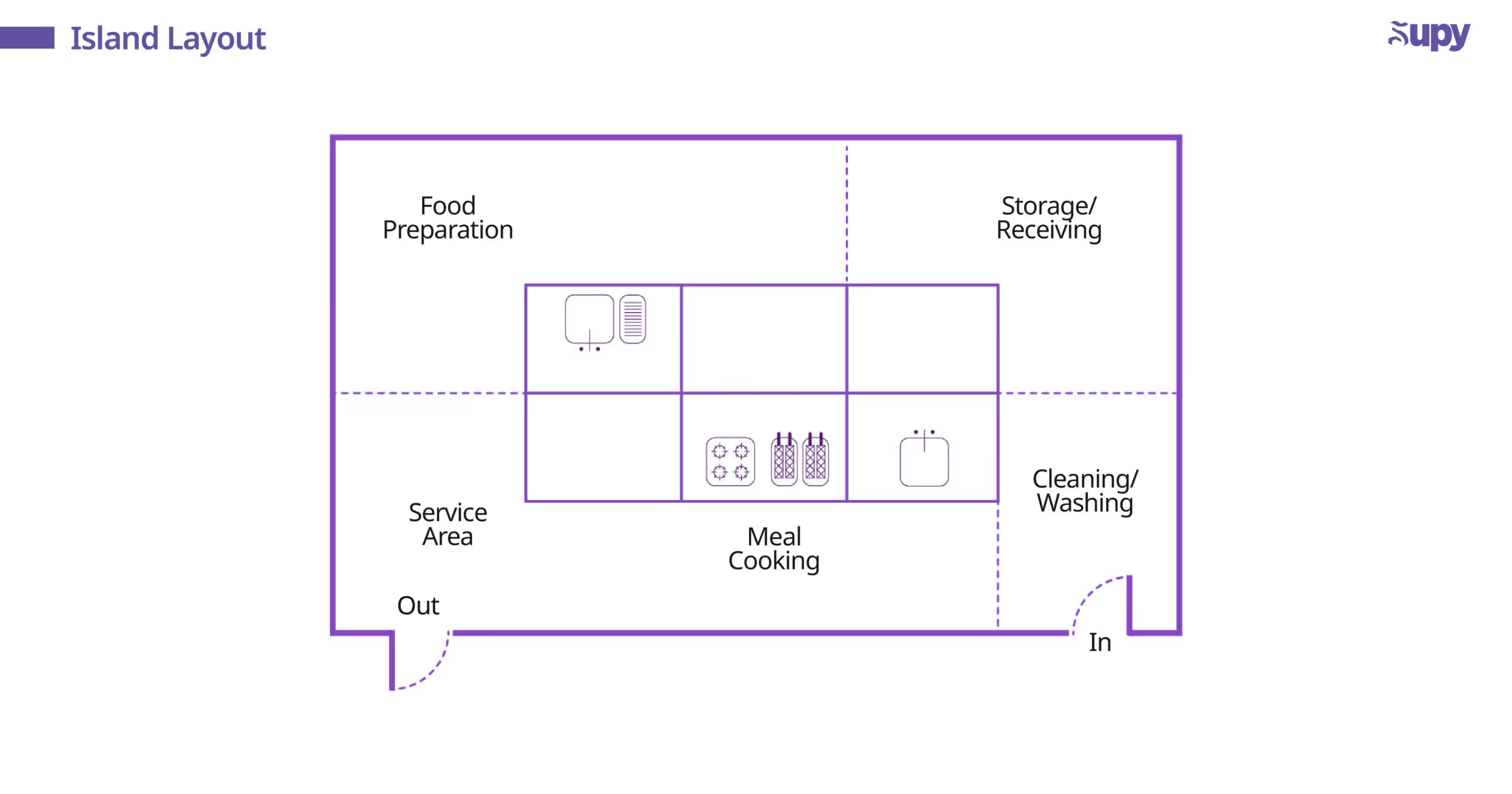
Best for: Large kitchens, catering businesses, and fine-dining restaurants
The island layout features a central workstation (the “island”) for prep or cooking, surrounded by other stations. This layout promotes collaboration and is excellent for spacious kitchens.
Key Features:
- Central island for high-priority tasks or shared use
- Surrounding zones for storage, cooking, and cleaning
- Encourages teamwork and clear communication
3. Zoning Layout

Best for: Full-service restaurants and establishments with diverse menus
Also known as the modular layout, the zone style layout divides the kitchen into specific zones for tasks like prep, cooking, and cleaning. It supports efficient multitasking and minimizes cross-contamination.
Key Features:
- Separate areas for each function (e.g., prep zone, cooking zone, cleaning zone)
- Logical placement of equipment to minimize movement
- Ideal for kitchens with multiple chefs working simultaneously
4. Galley Layout
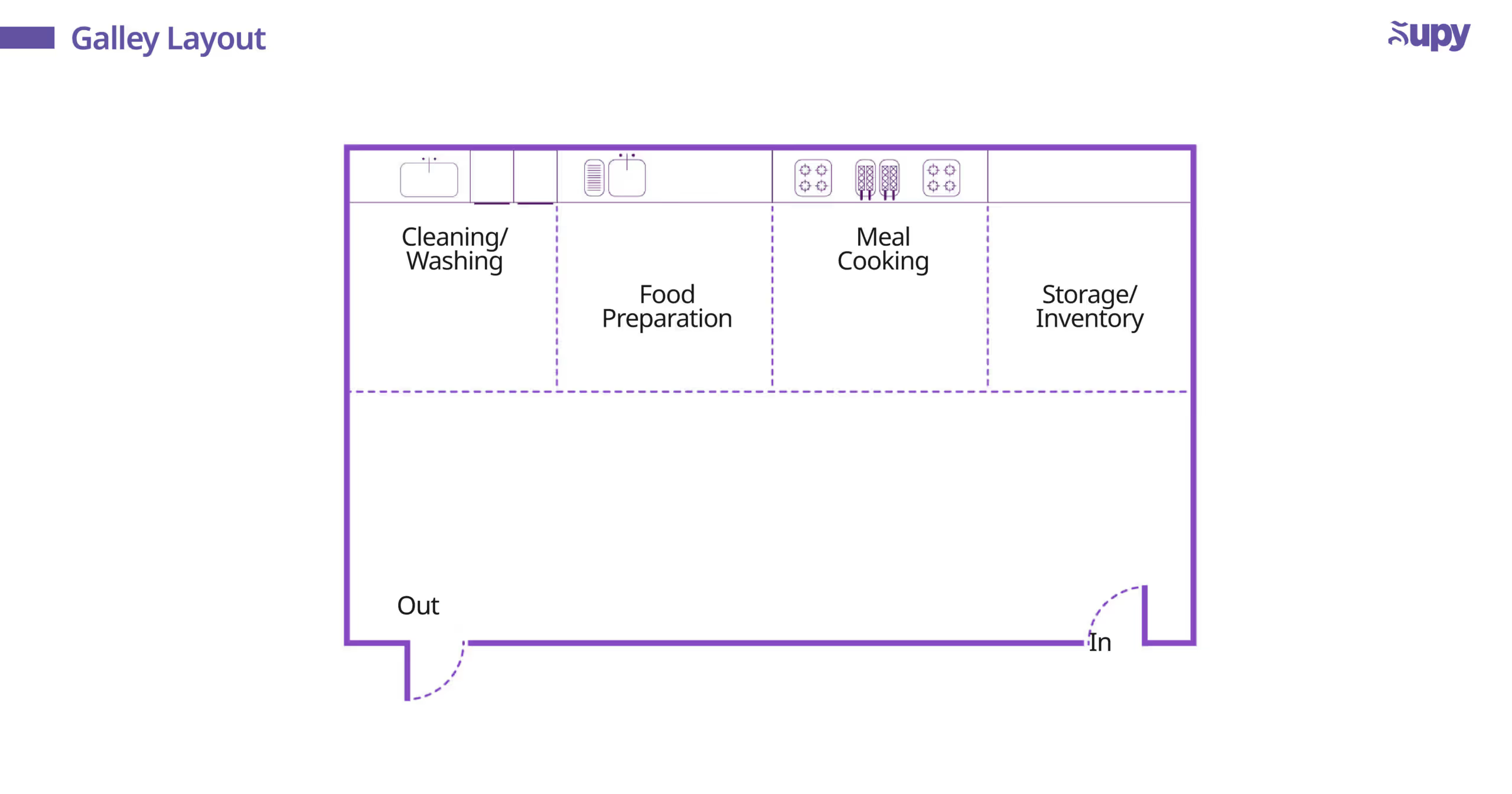
Best for: Food trucks, small cafes, and kitchens with limited space
The galley layout features two parallel countertops or workspaces with a walkway in between. This design maximizes every inch of space and keeps everything within easy reach.
Key Features:
- Compact design with efficient use of small spaces
- Appliances and storage placed on both sides for easy access
- Streamlined workflow for small teams
5. Open Layout
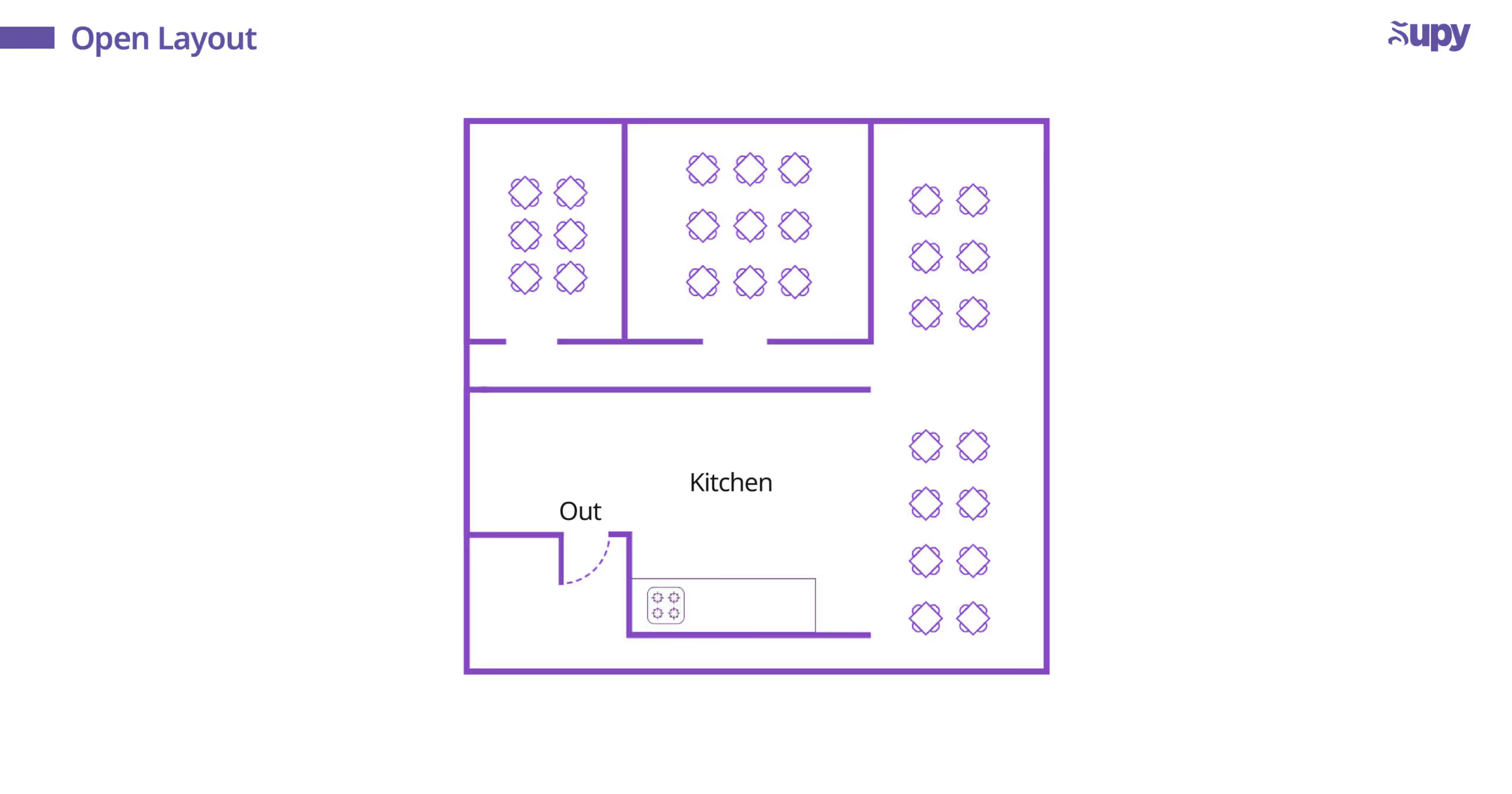
Best for: Show kitchens, interactive dining concepts, and modern eateries
An open layout blends the kitchen with the dining area, allowing customers to watch their food being prepared. It prioritizes aesthetics and transparency but requires meticulous organization.
Key Features:
- Visible workstations designed for both functionality and presentation
- Emphasis on cleanliness and organization
- Encourages interaction between chefs and diners
6. Conclusion
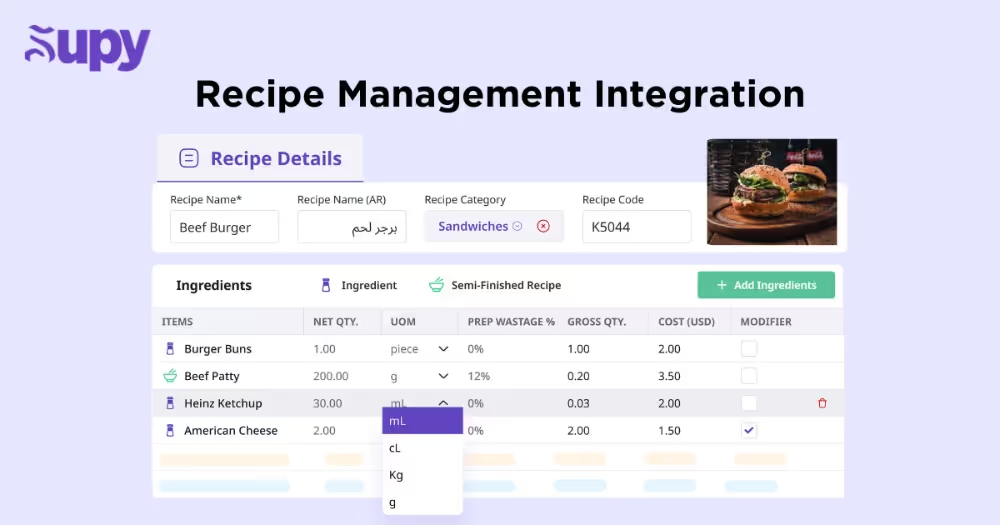
Designing the right restaurant kitchen layout is crucial in bringing your restaurant concept to life. Whether working with a compact space or a sprawling venue, thoughtful planning ensures restaurant efficiency, safety, and a seamless flow of operations. No matter the size of your kitchen, creating a functional space that supports your staff and enhances food preparation is key to delivering an exceptional dining experience. If you’re starting your own restaurant, investing time and effort into designing the perfect kitchen will set the foundation for long-term success.
7. About Supy
Supy is a powerful inventory management platform designed to streamline operations for restaurants of all sizes. Tailored for everything from compact commercial kitchen layouts to large-scale restaurant concepts, Supy ensures seamless control over stock, minimizes waste, and keeps your ingredients perfectly managed. With real-time insights and automated tracking, you can focus on delivering exceptional food and service. Book a demo with Supy today!







